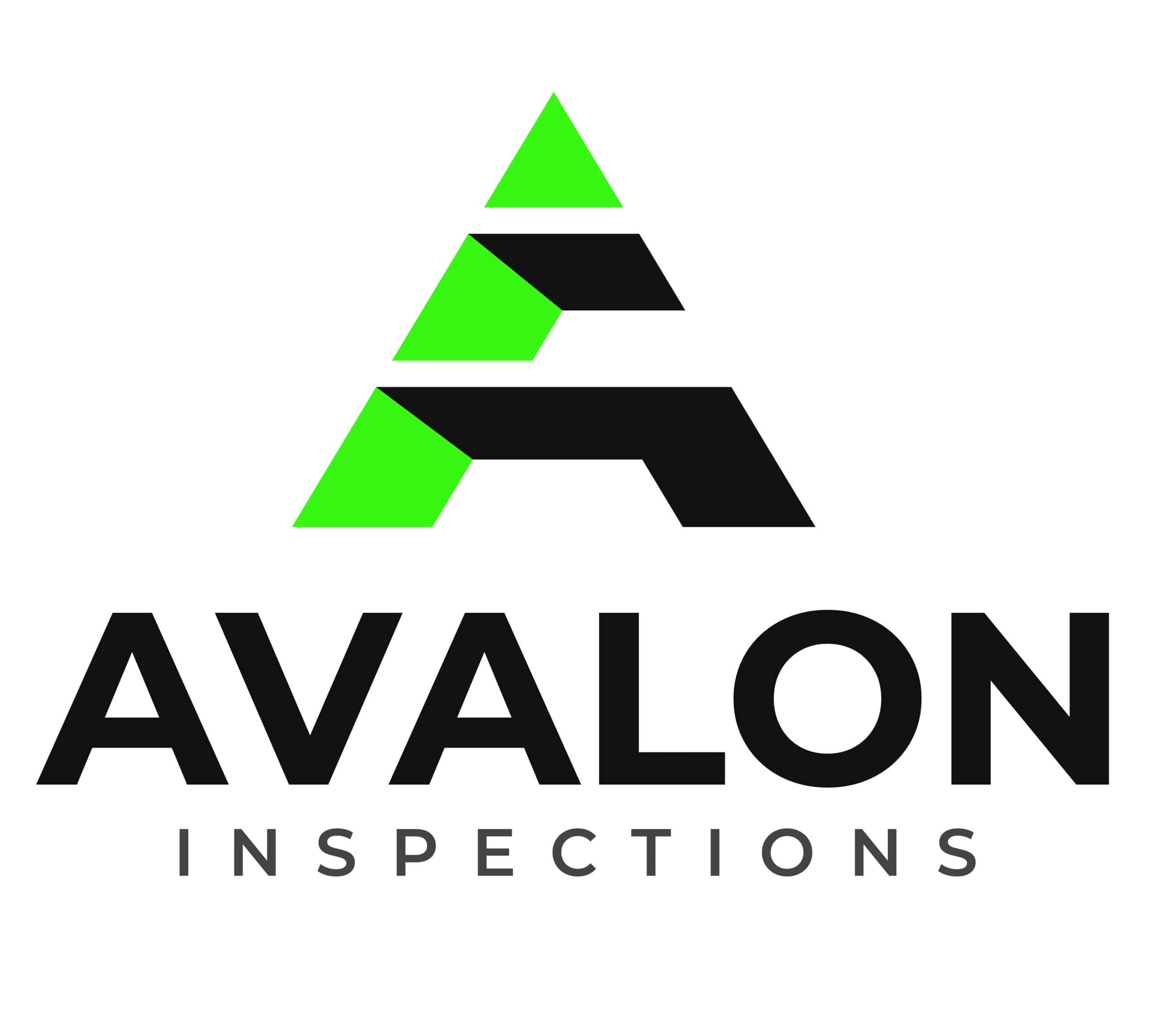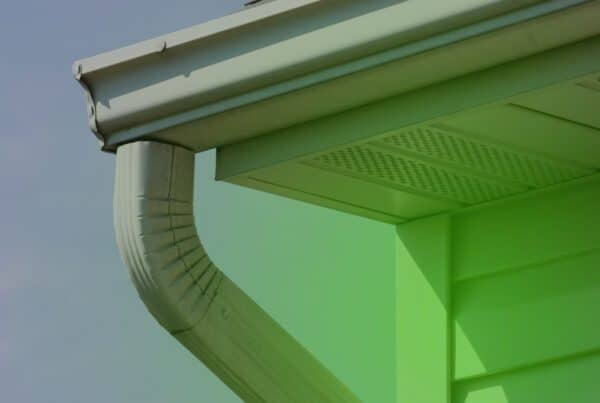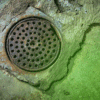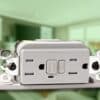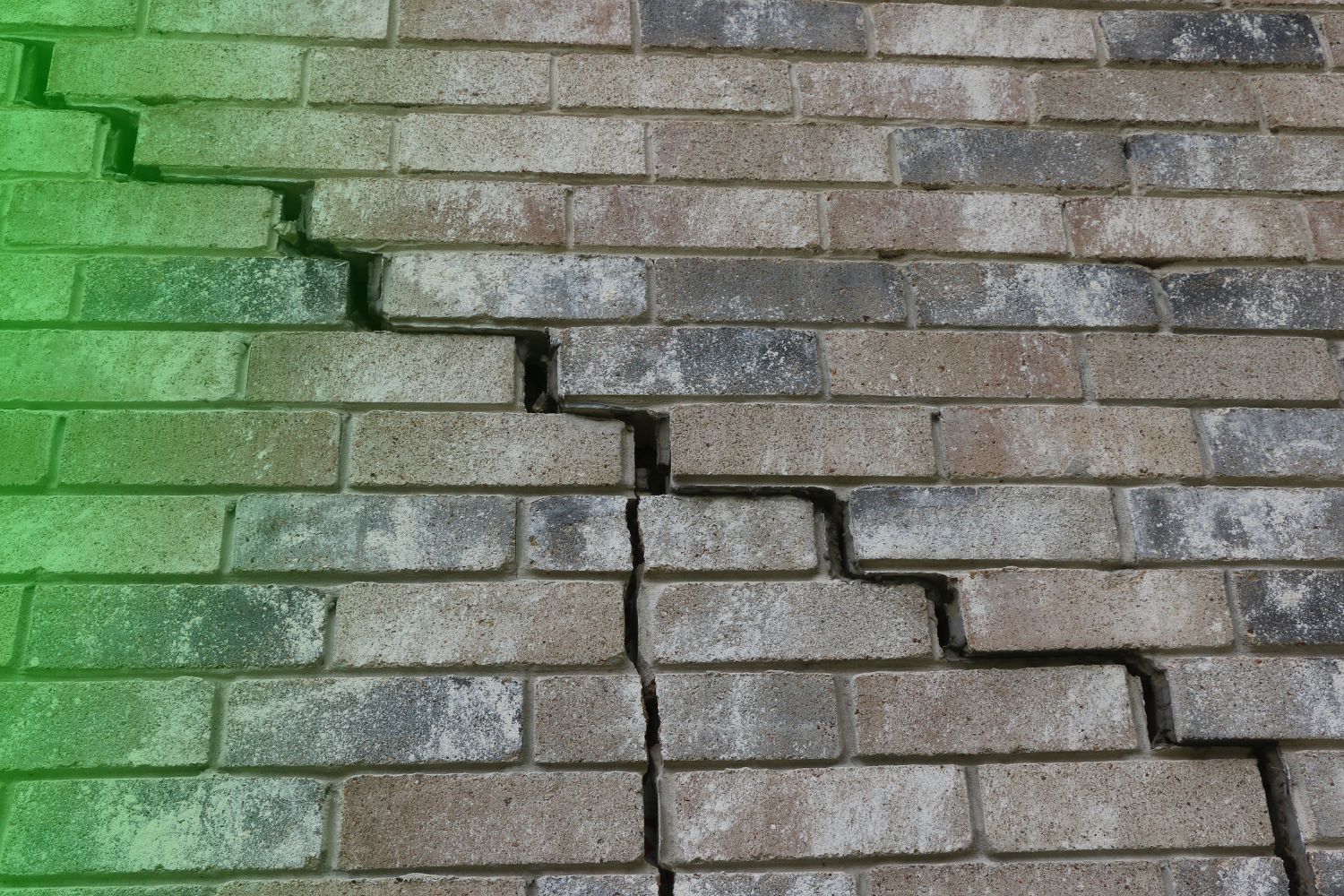
The foundation of a house determines how stable and safe everything above it will be. When it begins to weaken, the signs often start small: thin cracks in drywall, doors sticking, or a slight slope on the floor. Over time, those hints can turn into costly structural problems if ignored.
In metro Atlanta and throughout Georgia, foundations are constantly under pressure from the state’s famous red clay soil. This soil expands when it’s wet and shrinks when it dries, creating a repeating cycle that shifts concrete slabs and crawl space piers.
In this guide, you’ll learn how to recognize the signs of a weak foundation, what professional inspectors check during an evaluation, and how Avalon Home Inspections helps homeowners protect their structure before serious damage occurs.
Why Foundation Problems Are Common in Georgia
The strength of a foundation depends on the stability of the soil beneath it. Georgia’s dense, moisture-sensitive clay expands and contracts more than many soil types, and over time, that movement stresses the foundation.
Common causes of foundation issues in this region include:
- Heavy rainfall that saturates the soil and adds pressure to basement walls
- Drought periods that cause soil shrinkage and settlement
- Tree roots pulling moisture away unevenly around the house
- Poor drainage or downspouts that deposit water near the foundation
Each of these conditions alone may seem minor, but together they can create cracks, tilting, or uneven support.
Together, these conditions create the foundation movement patterns inspectors see most often.
The signs below can help reveal whether that movement has begun in your home.
Cracks in Walls and Ceilings
Cracks are often the first clue that something is wrong. While tiny hairline cracks can appear naturally as a house settles, wider or expanding ones may indicate structural movement.
| Crack Type | Possible Cause | Level of Concern |
|---|---|---|
| Thin vertical lines | Normal settling | Low |
| Diagonal cracks near doors or windows | Uneven soil movement | Moderate |
| Horizontal cracks in basement or crawl walls | Soil pressure and moisture buildup | High |
| Step-shaped cracks in brick or mortar | Shifting corners or sinking slab | High |
If cracks widen beyond one-eighth inch or continue spreading after patching, it’s time to call a professional.
During inspections, Avalon uses digital measuring tools to monitor crack size and track whether movement is still active.
Uneven or Sloping Floors
Sloping floors are another common warning sign. Many homeowners first notice this when furniture leans slightly or objects roll on their own.
Uneven floors occur when sections of the foundation sink or lift at different rates. In Georgia, seasonal soil expansion under concrete slabs or rotted crawl space beams can both cause this effect.
Inspectors check the slope using precision leveling tools and note whether it runs consistently in one direction or varies across rooms. Minor slope from age may be normal, but sudden or severe changes usually point to foundation shifting or moisture beneath the home.
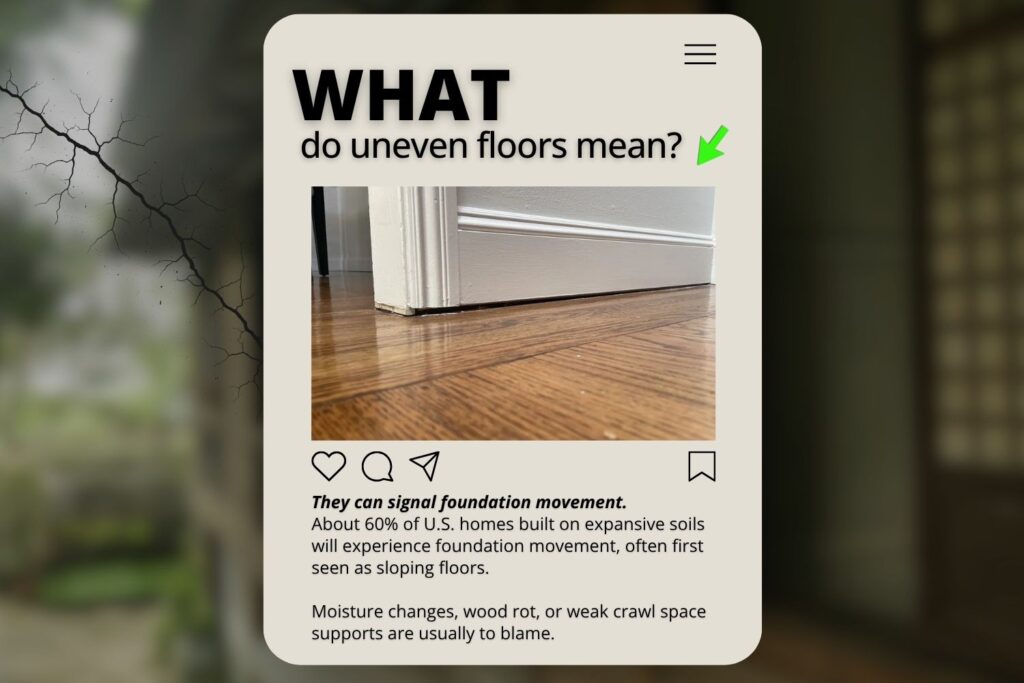
Doors and Windows That Stick
When a foundation moves, it pulls door and window frames out of alignment. What looks like a stubborn door may actually be a structural symptom.
Inspectors look for:
- Gaps at the top or bottom of door frames
- Locks or latches that no longer align
- Windows that jam or rub when opened
- Cracked trim or separation between molding and drywall
Sometimes humidity causes similar behavior, so inspectors test both the frame alignment and moisture conditions. If sticking doors appear along with wall cracks or floor changes, the issue likely extends beyond humidity.
Gaps Between Walls, Ceilings, and Floors
Open gaps in corners or where ceilings meet walls suggest that the home’s frame is shifting. You might also see molding pulling away from drywall or nail pops forming along seams.
Inspectors evaluate how wide these gaps are and whether they are expanding. In homes with crawl spaces, uneven pier settlement is often the culprit.
A consistent pattern of separation between rooms usually signals foundation movement rather than minor settling.
Exterior Cracks in Brick, Stucco, or Concrete
Foundation strain often appears first on the outside of the house. Check for:
- Zigzag cracks following mortar joints
- Separation where walls meet porches or chimneys
- Flaking or crumbling concrete at the base of walls
When inspectors find step-shaped cracks or bulging walls, they measure displacement to determine whether one side of the home is sinking faster than the other.
These observations help identify whether stabilization or drainage correction is needed.
Water Intrusion or Damp Basements
Water and foundation problems are closely linked. Persistent moisture near a foundation causes erosion, hydrostatic pressure, and cracks in basement walls.
Watch for:
- Musty odors or visible mold
- Peeling paint on concrete walls
- White mineral streaks called efflorescence
- Pooled water after heavy rain
During a professional inspection, Avalon uses moisture meters and thermal cameras to pinpoint problem zones. If left unresolved, basement humidity can weaken concrete and lead to long-term structural damage.
Crawl Space or Pier Deterioration
Homes with crawl spaces rely on pier and beam systems that are vulnerable to moisture and insects. Inspectors often find:
- Wood rot or termite damage on beams
- Cracked or leaning masonry piers
- Rusted metal supports or shims
- Loose or missing vapor barriers
Avalon inspectors check whether the vapor barrier fully covers the soil and whether humidity control systems are in place. Consistent crawl space moisture is one of the fastest ways a foundation can weaken without homeowners realizing it.
Plumbing and Utility Shifts
When a house moves, so do the pipes and wiring inside it. Foundation shifts often strain plumbing lines, causing leaks that worsen the original movement.
Signs include:
- Reduced water pressure
- Wet spots on floors or near walls
- Frequent drain backups
- Cracked bathroom tiles
Inspectors monitor water meter activity and use thermal imaging to detect leaks under slabs. Repairing these early helps stop the cycle of soil softening and settlement.
Pest Activity Around the Foundation
Pests such as termites, carpenter ants, and rodents take advantage of foundation cracks and gaps. In Georgia’s mild climate, they stay active year-round.
Cracks that begin as small openings for moisture can quickly turn into pest entry points. A pest professional should look for insect tunnels, wood damage, and debris buildup near crawl space vents or foundation joints.
Foundation damage and pest infestations often appear together, and treating one without the other rarely solves the problem.
Minor vs. Major Foundation Concerns
Understanding which signs are urgent helps homeowners prioritize inspections before repairs become costly.
| Condition | Typically Minor | Requires Professional Review |
|---|---|---|
| Hairline cracks under 1/8 inch | ✔ | |
| Slight door sticking during humidity | ✔ | |
| Sloping floors greater than 1 inch per 20 feet | ✔ | |
| Cracks through brick or foundation slab | ✔ | |
| Repeated moisture or pooling at base | ✔ |
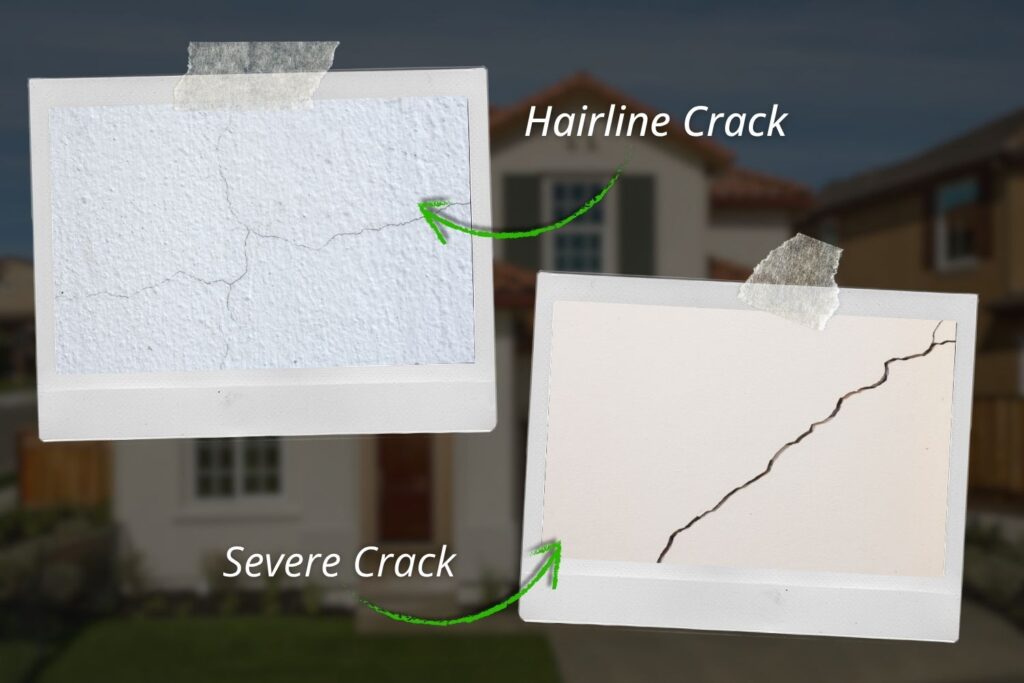
How Inspectors Evaluate a Foundation
A thorough inspection goes well beyond what homeowners can see. Avalon Home Inspections follows a structured process to assess every aspect of a house foundation:
- Elevation Mapping: Inspectors measure multiple floor points to detect unevenness across the structure. This identifies where movement has occurred and whether it is active.
- Moisture Detection: Tools such as hygrometers and infrared cameras locate leaks and water vapor sources that can destabilize soil.
- Structural Observation: The inspector examines walls, beams, and piers for tension cracks, wood decay, or separation.
- Drainage Review: They check how well gutters, grading, and downspouts carry water away from the home.
- Documentation and Reporting: Every finding is summarized with photographs, diagrams, and suggested repair or monitoring steps.
At Avalon, we also assess how long certain conditions have likely been developing. That insight helps homeowners decide between simple maintenance and professional foundation repair.
Foundations are not static; they change slowly over time. Regular inspections provide a record of those changes so early intervention is possible.
Preventing Future Foundation Issues
Once the foundation of a house has been evaluated, the next step is prevention. Small adjustments in maintenance routines can make a big difference.
Keep Moisture Balanced Around the House
Soil that stays evenly moist resists expansion and contraction. Use soaker hoses or drip irrigation during long dry spells, but avoid overwatering near the foundation itself.
Manage Drainage and Grading
Check that the ground slopes away from your home at least six inches over the first ten feet. Extend downspouts five feet or more from the foundation to prevent pooling water.
Protect Crawl Spaces
Install vapor barriers that fully cover the soil and seal gaps around vents. Consider a dehumidifier to keep humidity below 60%.
Inspect Seasonally
Walk the perimeter of your home each spring and fall to look for new cracks or changes. If anything seems different, schedule a professional checkup with Avalon before the next heavy rain season.
Maintain Trees and Landscaping
Tree roots naturally seek moisture and can shift soil beneath the foundation. Keep large trees at least 15 to 20 feet from the house and trim roots that grow toward it.
Foundation prevention is an ongoing task, but once you know what to look for, it becomes part of regular home care instead of a major concern.
Related Questions
What Does a 5-Point Inspection Include?
Avalon’s 5-Point Inspection covers your foundation, roof, plumbing, electrical, and HVAC systems to give a complete picture of your home’s condition. It’s especially valuable for identifying early structural concerns.
How Do Crawl Space Conditions Affect the Foundation?
Moisture, wood rot, or poor ventilation in a crawl space can weaken support piers and lead to foundation movement. A crawl space inspection helps catch these issues early.
Should I Get a Thermal Imaging Inspection for My Home?
Yes. Infrared tech helps detect hidden moisture or temperature changes that may point to foundation leaks, poor insulation, or electrical issues before they become costly.
When to Call a Professional
If you see multiple signs such as wall cracks, uneven floors, or persistent moisture, schedule a structural inspection as soon as possible. Ignoring early signs often allows small problems to become major repairs.
Avalon Home Inspections performs detailed foundation and 5-Point inspections throughout the Atlanta area. Their certified inspectors combine modern tools with practical experience to identify structural risks accurately.
A professional report helps you understand your home’s condition, plan repairs confidently, and prevent future movement before it affects your home’s safety or value.
Conclusion
A weak foundation can silently affect every part of your house, from the roofline to the flooring. Recognizing the early warning signs and understanding how Georgia’s climate impacts your foundation can help you act before damage spreads.
Whether you are buying a home, planning renovations, or noticing cracks for the first time, their team ensures you have the answers you need.
Schedule your inspection today and keep your house standing strong for years to come.
